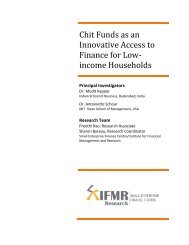Government of India Volume I: Analysis and Recommendations
Government of India Volume I: Analysis and Recommendations
Government of India Volume I: Analysis and Recommendations
Create successful ePaper yourself
Turn your PDF publications into a flip-book with our unique Google optimized e-Paper software.
PUBLIC DEBT MANAGEMENT<br />
State <strong>Government</strong>s, the public debt management agency should co-ordinate the Central<br />
<strong>Government</strong> borrowing calendar with the borrowings <strong>of</strong> State <strong>Government</strong>s to ensure<br />
that the auctions <strong>of</strong> new issues are appropriately spaced.<br />
The operations <strong>of</strong> the public debt management agency should also keep in mind investor<br />
preferences <strong>and</strong> the ultimate objective <strong>of</strong> public debt management, i.e., to meet<br />
the financial needs <strong>of</strong> the Central <strong>Government</strong> in an efficient manner over the long run.<br />
However, the final decision will rest with the Central <strong>Government</strong>. Once the Central <strong>Government</strong><br />
has made decisions on the key questions, its remit would be executed by the<br />
public debt management agency.<br />
Over the medium-term, the public debt management agency’s focus is likely to shift<br />
towards building voluntary dem<strong>and</strong> for <strong>India</strong>n <strong>Government</strong> paper. It may consider a<br />
range <strong>of</strong> alternatives such as issuing inflation-indexed bonds or issuing in foreign currency,<br />
aiming to establish mechanisms that help address market concerns regarding inflation,<br />
exchange rate <strong>and</strong> credit risk, so as to minimise the interest cost paid by the Central<br />
<strong>Government</strong> in the long run.<br />
As things st<strong>and</strong> today, external debt includes loans received from foreign <strong>Government</strong>s<br />
<strong>and</strong> multilateral institutions. The foreign currency borrowing <strong>of</strong> the Central <strong>Government</strong><br />
takes place through multilateral <strong>and</strong> bilateral agencies. There is no direct borrowing<br />
from international capital markets. Further, State <strong>Government</strong>s cannot directly<br />
borrow from abroad <strong>and</strong> have to go through the Central <strong>Government</strong> as the sovereign<br />
risk is borne by the latter. Considering all these, both internal <strong>and</strong> external debt should<br />
fall under the scope <strong>of</strong> the public debt management agency.<br />
Wherever feasible, the public debt management agency should establish limits for<br />
various categories <strong>of</strong> risk <strong>and</strong> overall risk. It must also seek to insure against these risks<br />
inherent in its portfolio. It should also develop a framework that helps identify the risks<br />
in the portfolio more efficiently, such as those associated with public debt management<br />
operations, refinancing, contingent liabilities, impact <strong>of</strong> sovereign credit ratings issued<br />
by credit rating agencies <strong>and</strong> global <strong>and</strong> domestic business cycle risks. It should also coordinate<br />
with the fiscal <strong>and</strong> monetary policy functions, <strong>and</strong> actively engage with credit<br />
rating agencies <strong>and</strong> the private sector <strong>and</strong> build relationships with market participants.<br />
12.3.2. Cash management<br />
The Central <strong>Government</strong> has been consistently running large fiscal deficit over the years.<br />
In this situation, cash surpluses do not arise except for very short periods <strong>of</strong> time, due<br />
to temporary mismatches between receipts <strong>and</strong> expenditures within a given financial<br />
year. However, the public debt management agency should be tasked with the function<br />
<strong>of</strong> managing <strong>and</strong> investing surplus cash <strong>of</strong> the Central <strong>Government</strong> whenever such a situation<br />
arises in future.<br />
There is also a need for the efficient management <strong>of</strong> cash balances across various departments<br />
<strong>and</strong> ministries <strong>of</strong> the Central <strong>Government</strong>. Currently, a large part <strong>of</strong> the funds<br />
received by the various departments <strong>and</strong> ministries <strong>of</strong> the Central <strong>Government</strong> are held<br />
as surplus cash. This results in inefficient cash management for the Central <strong>Government</strong><br />
as a whole. This is because the Central <strong>Government</strong> might be required to borrow in the<br />
market in a deficit situation even while some <strong>of</strong> its ministries hold on to surplus balances.<br />
The cash balance position <strong>of</strong> the Central <strong>Government</strong> is also closely linked to the<br />
balances <strong>of</strong> State <strong>Government</strong>s, since the latter temporarily place surpluses with the Central<br />
<strong>Government</strong>. The frictional factors that contribute to the unintended liquidity crunch<br />
from time to time can be avoided if better cash management practices are introduced<br />
by both Central <strong>and</strong> State <strong>Government</strong>s in harmony with their public debt management<br />
practices.<br />
FINANCIAL SECTOR LEGISLATIVE REFORMS COMMISSION 115



